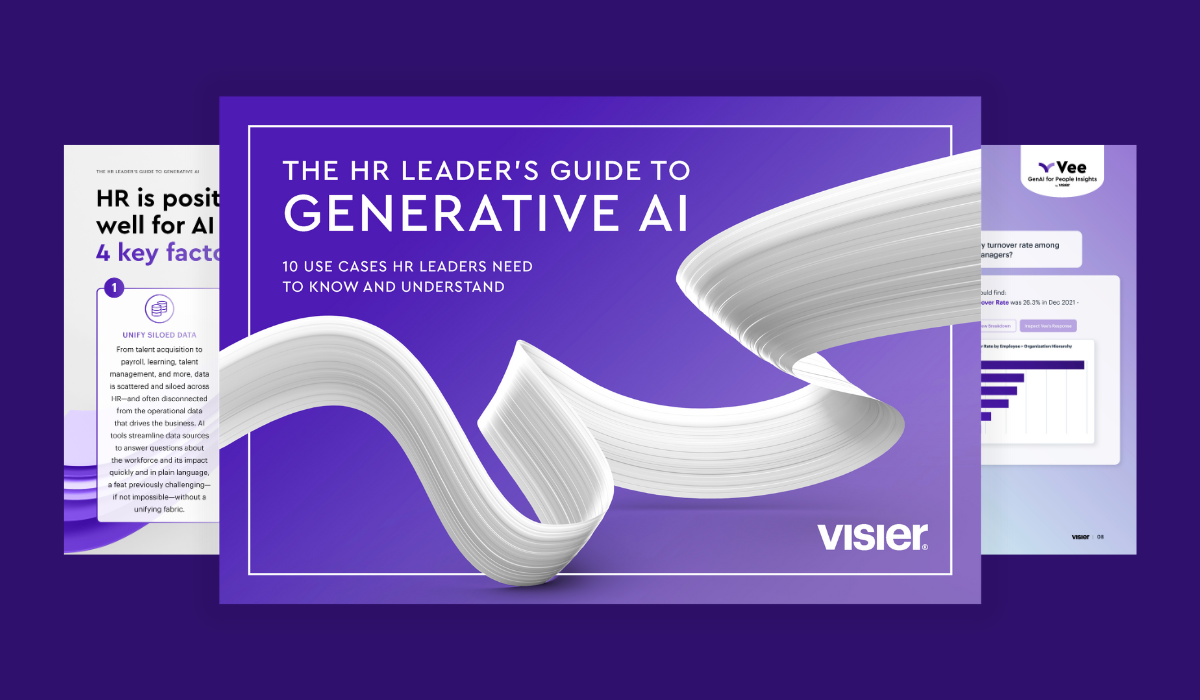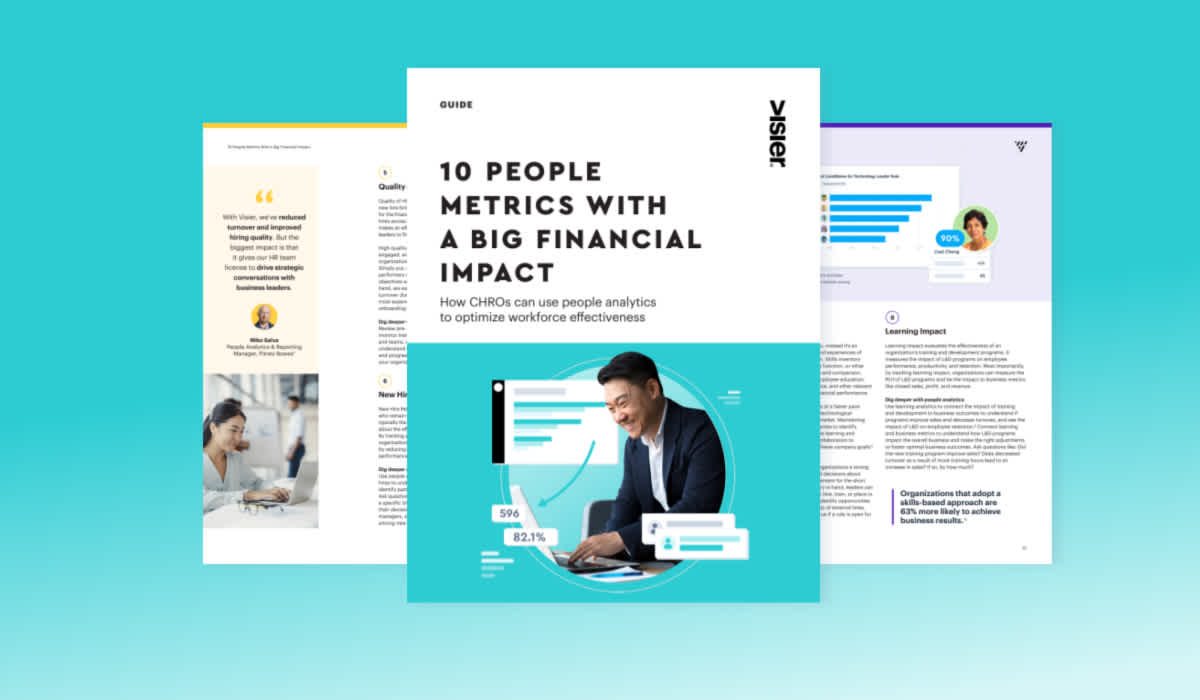15 Strategic Workforce Planning Questions Vee Can Answer Fast
Visier's genAI assistant, Vee, answers strategic workforce planning questions in seconds. Here are 15 real examples of answers from Vee.
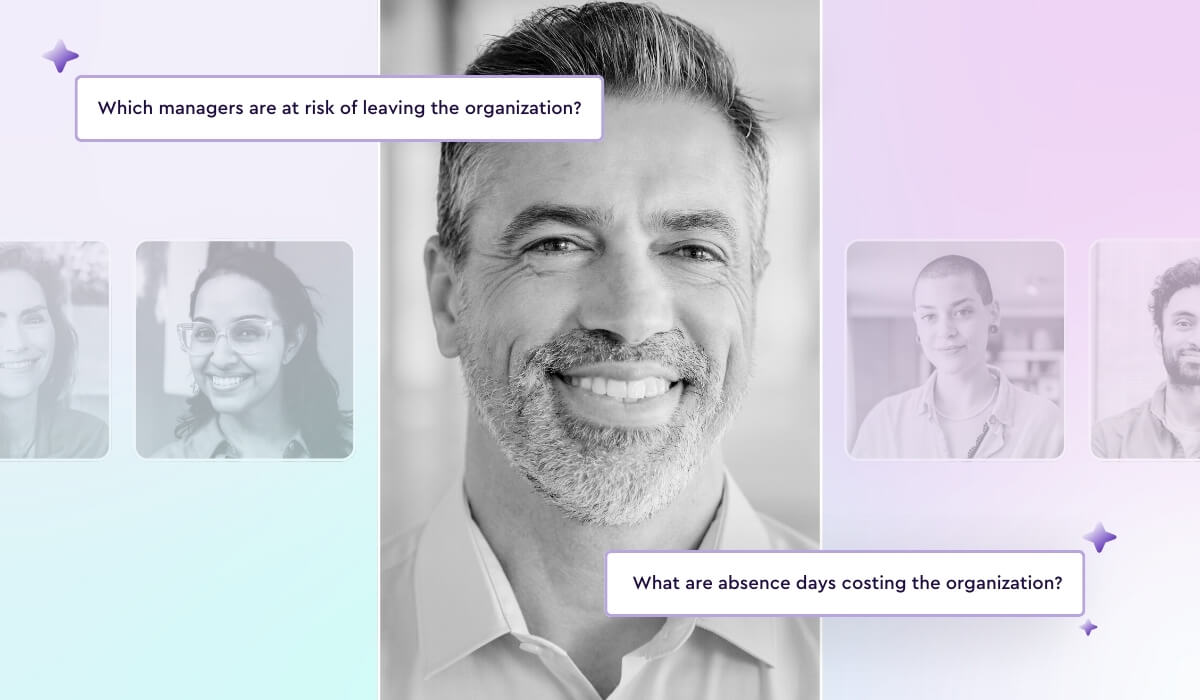
This post is part of a series of questions to ask generative AI for people analytics. Explore other posts in the series to learn which questions AI can answer for compensation and total rewards teams, HRBPs, people analytics leaders, frontline managers, and CHROs.
The workplace is continuously evolving, impacted by macro shifts like fluctuating labor markets, and internal changes like shifting headcounts, organizational design, and skills. Because people affect every business outcome, strategic workforce planning is essential to making data-driven workforce decisions that support the needs and goals of the business. HR leaders and human resource business partners (HRBPs) need the ability to make adjustments in the face of change—and they need the right information fast.
Agility is critical in workforce planning today. The pace of technological changes, new legislation and regulations, and the shifting competitive landscape mean that companies simply don’t have time to rely on traditional annual workforce planning cycles. Companies need to minimize risks and capitalize on opportunities through workforce planning efforts.
![[ANIMATED SHORT] Workforce Planning Questions](https://images.ctfassets.net/lbgy40h4xfb7/1o85kzcXWAMAxqTT9fjDn1/807d9b5560040f14b90a06bb25084e77/ask-vee-thumbnail.jpg?w=1200&h=700&fl=progressive&q=50&fm=jpg)
Generative AI tools like Visier’s Vee can provide HR executives, line managers, and people analytics teams with fast answers to their workforce planning questions based on their organization’s data, as well as external benchmarking data that can improve their decision-making accuracy.
Here are 15 strategic workforce planning questions that Vee can answer in seconds.
1. How many employees do we have?
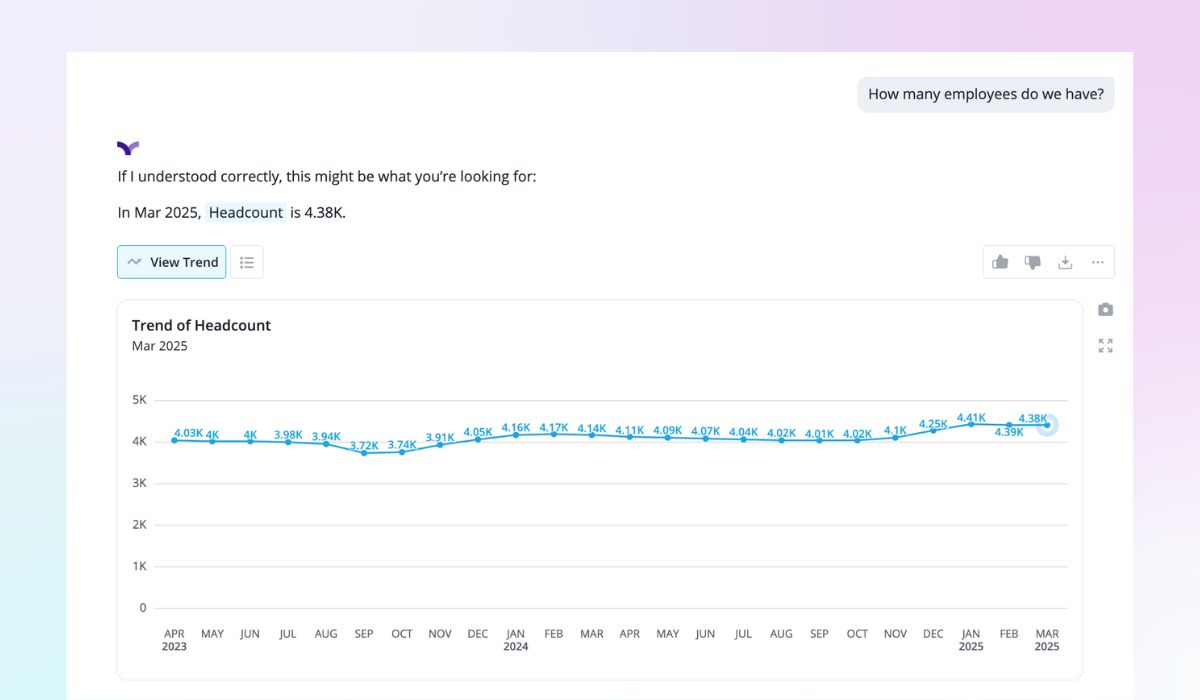
Workforce planning begins with an accurate understanding of how many employees you have on board. But headcount isn’t as straightforward as it may initially seem. How many full-time equivalents (FTEs) do you have? How many seasonal employees? Temporary employees? How do these numbers vary by department, division, or location?
In addition to the foundational importance of having an accurate count of employees, it’s also important to monitor this metric over time to see how your workforce expands or contracts. For HR leaders, this can provide an early warning sign for detecting potential talent gaps.
When combined with revenue metrics, this metric will also give you an indication of revenue per employee, a key productivity measure.
2. How many employees started in each location last quarter?

Understanding how your employee numbers vary by location can provide insights into talent acquisition strategies, productivity variations, and trends in staffing over time. Looking at staffing levels geographically can ensure that staffing aligns with any strategic expansion or contraction in production or market service areas.
Evaluating location-based hiring trends over time is also a good way to evaluate the effectiveness of regional talent acquisition strategies. HR leaders can use this information to identify locations that meet or exceed hiring targets and where additional recruitment resources may be needed.
3. How much does our headcount cost by level?
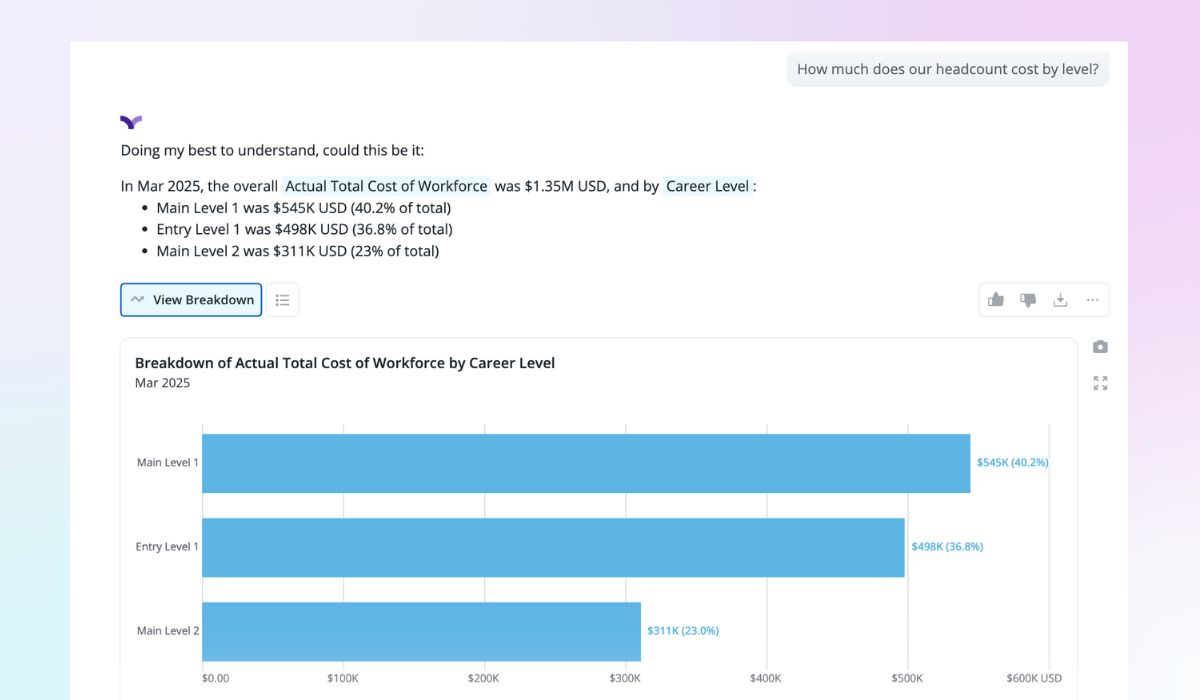
In addition to understanding the number and type of employees in your workforce, it can also be helpful to know how much these human resources cost. A breakdown by career level can provide insights for workforce planning and staffing budget optimization.
Tracking headcount costs compared to productivity over time can also help determine if your HR investments at various levels or areas of the organization are generating appropriate returns. This can provide an early indication of where budgets may need to be adjusted to increase or decrease staff.
4. How has headcount changed YoY compared to TCOW?

Monitoring how the headcount shifts year over year (YoY) compared to the total cost of workforce (TCOW) provides an indication of HR’s contribution to organizational financial performance. Supporting business growth while also maintaining or reducing staffing costs indicates the positive impact of strategic workforce planning.
This metric can be impacted through restructuring, optimizing skill mix, or overall compensation management. When analyzing trends over time, consider what might be influencing shifts—e.g., geographic distribution of employees, length of service, shifts in reliance on contractors, etc.
5. What is the turnover rate by department for the past year?
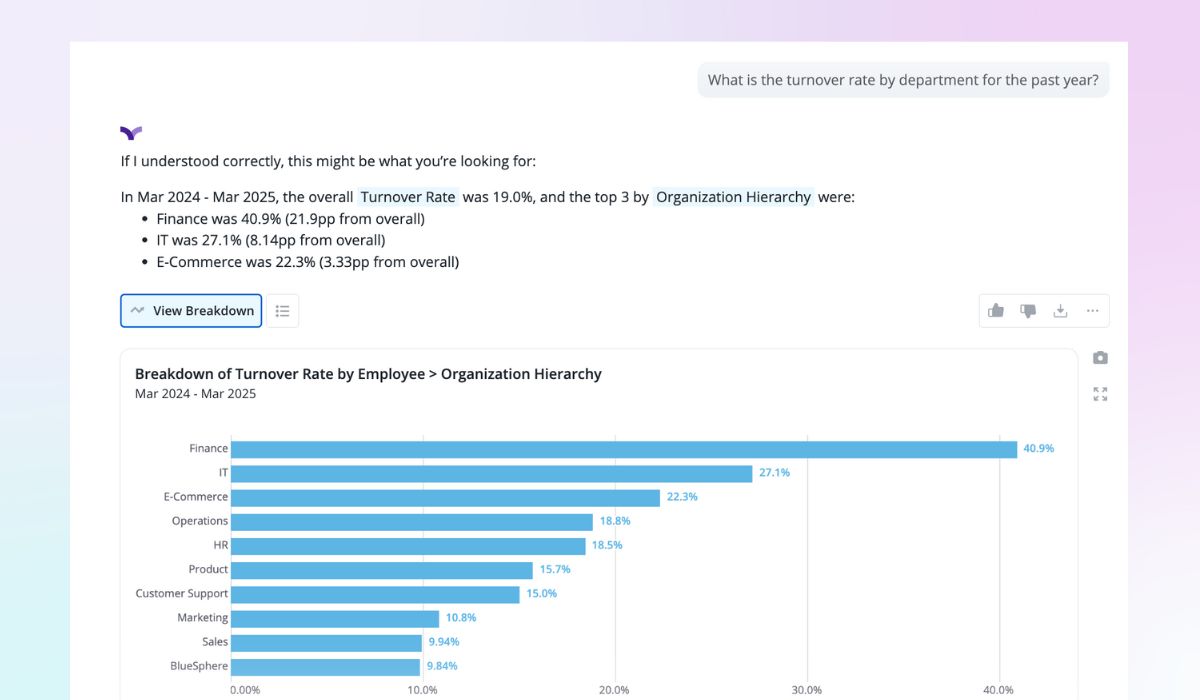
Turnover is costly and is an important metric to be managed. By continually monitoring both levels and trends in turnover, and considering these numbers by department, division, location, or manager, you can spot potential early warning signs or areas exhibiting best practice management.
In reviewing these numbers, it’s important to compare to benchmarks by industry, geography, or competitor, as available. Having benchmarks can help you determine whether a number is really “high” or “low” based on similar comparisons. For instance, turnover in call center environments can be high, so a high number may not be cause for alarm.
Understanding where turnover levels may be a concern can help you target strategic interventions to impact those numbers over time. Different departments may require different retention strategies based on their unique turnover drivers.
6. Which departments have the highest rate of absenteeism?
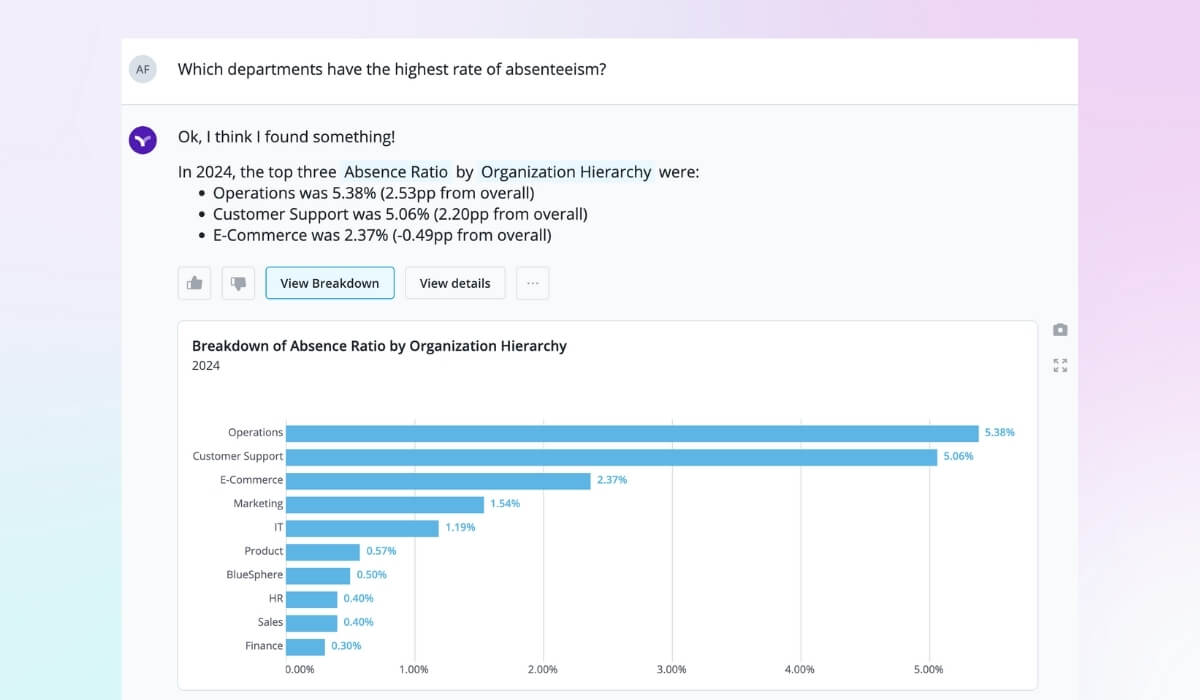
Absenteeism can have a significant impact on both productivity and morale. Absenteeism can be a signal of employee dissatisfaction and may point to the need for education of supervisors and managers.
Analyzing attendance data across your organization can help you pinpoint teams that might need intervention—like improved policies, training, or more support. This information can also help identify areas where workloads may need to be reallocated or temporary help may be required. Benchmarking absenteeism between departments can also help point to best practices that can be shared with teams where absenteeism is high.
7. How does the current headcount in the customer support organization compare to last year?
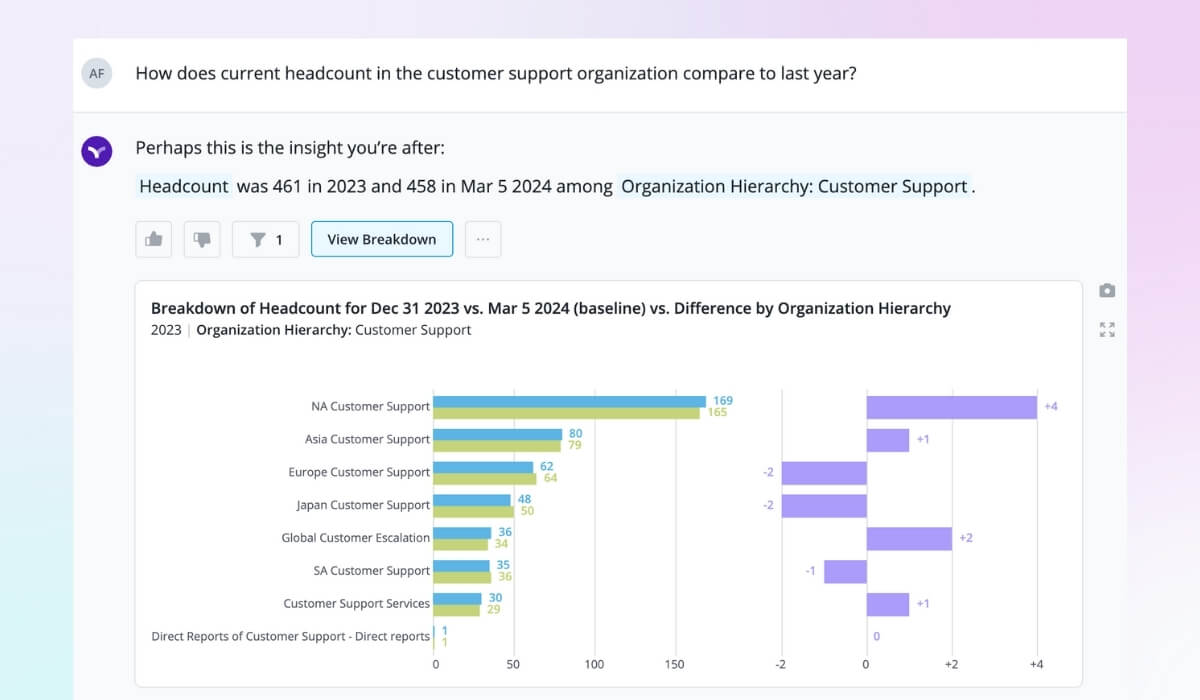
In addition to comparing departments to one another, you can dig into a specific department to further understand its strengths and opportunities. For instance, the customer service organization has the second-highest absenteeism rate in the first example. With Vee, you can zoom in on the customer support department and take a closer look at how headcount has changed in the past year to identify areas of potential concern where turnover and attrition may be spreading resources too thin.
Additionally, comparing this data to customer service and satisfaction data can help provide insights about optimum staffing levels and how they impact revenue and other business metrics.
8. Which managers are at risk of leaving the organization?
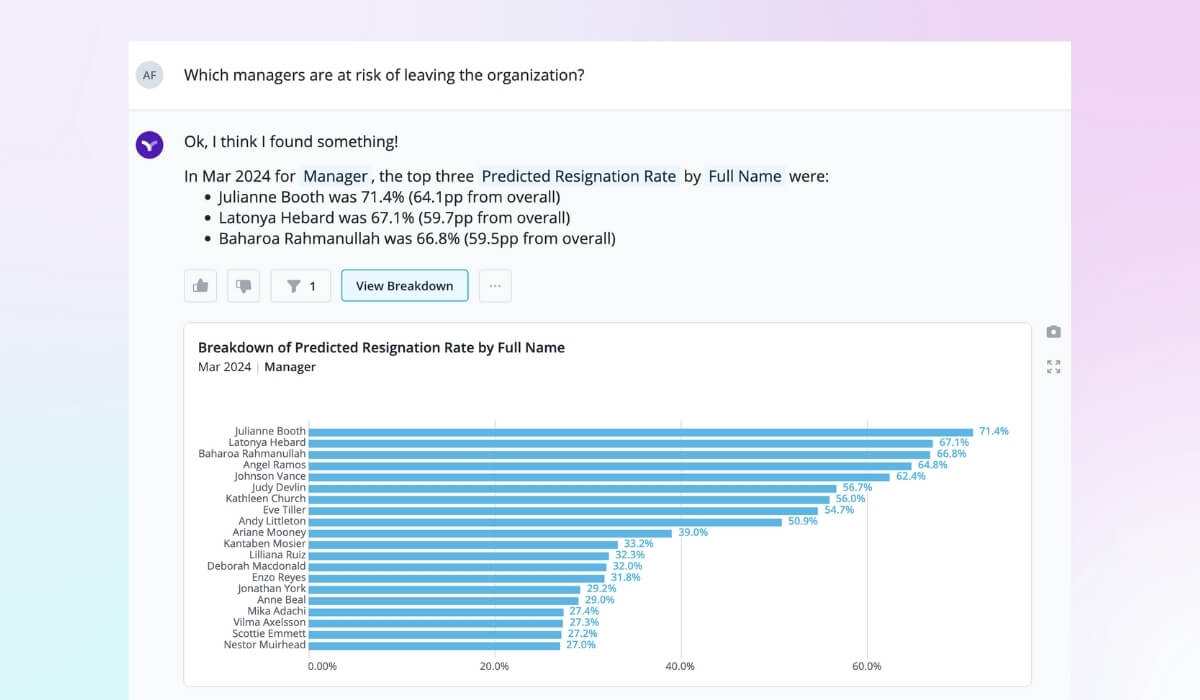
Managers play a critical role in every organization. They’re the direct point of contact for employees and the source of direction, feedback, and support. Vee can help organizations gain insights into the risk of attrition for specific managers, enabling HR teams with the information they need to act quickly.
By analyzing data points like performance ratings, compensation, engagement, and other factors, HR teams can prioritize retention efforts, conduct stay interviews, and develop succession plans to help groom high-potential employees to step into managerial roles where turnover is likely.
9. How has our manager instability ratio changed year over year?
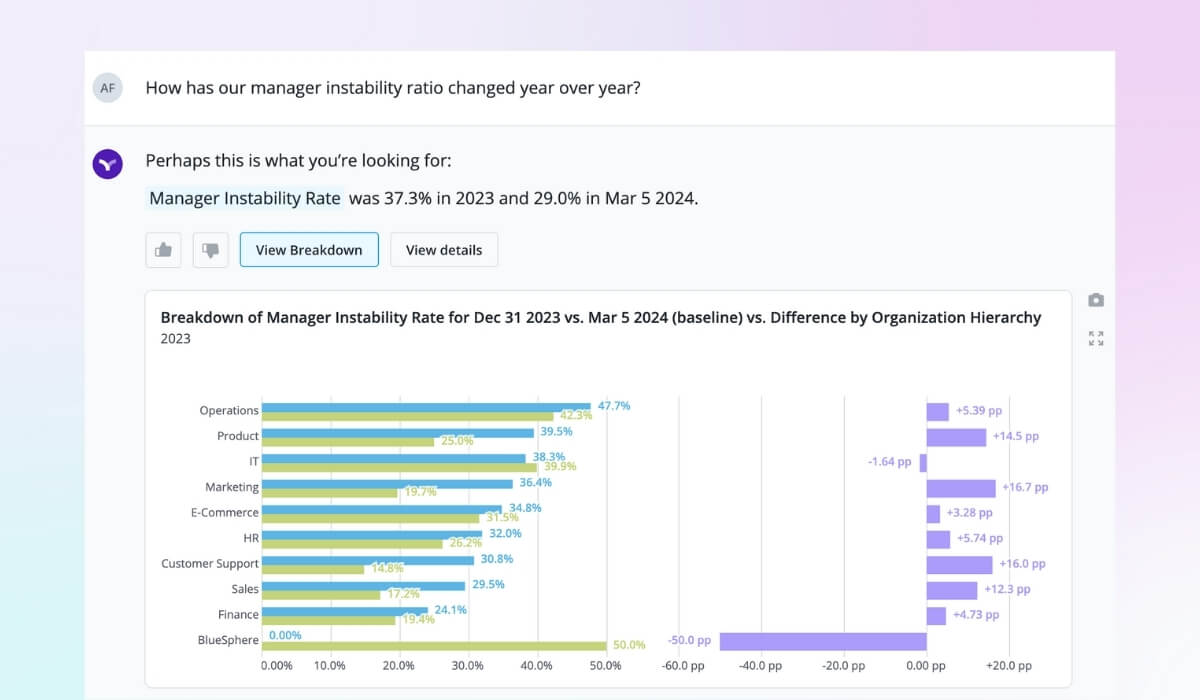
The manager instability ratio is a measure of the percentage of employees who had more than one manager over the course of a specific time period, generally a year. It’s an important metric to monitor because manager instability can lead to lower employee engagement, reduced productivity, and retention risks.
By understanding where manager instability may be high, organizations can take steps to analyze root causes (e.g., lack of growth opportunities) and proactively intervene to head off these risks. Monitoring how the rate fluctuates can offer insights into the effectiveness of these efforts.
10. How many open requisitions do we need to fill this quarter?
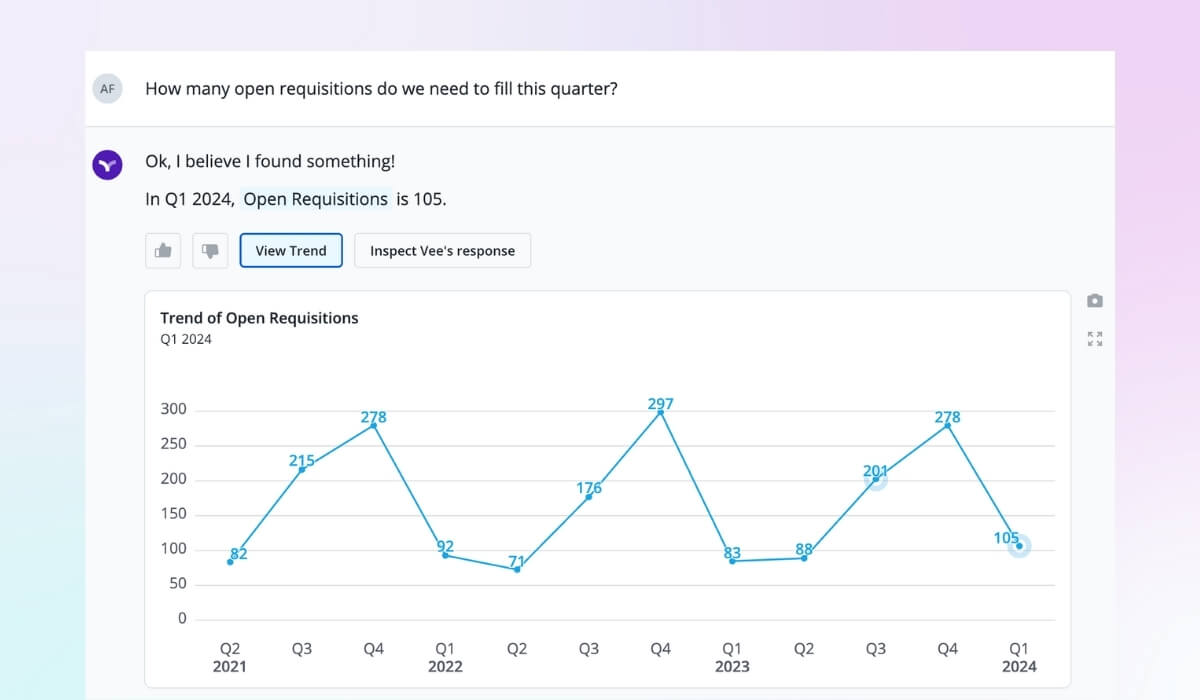
A lot of time and effort goes into filling open staff requisitions. If organizations can address these requisitions promptly, they’ll experience less impact from reduced productivity and a better opportunity to fill open roles with qualified candidates.
Open requisition rates may also give insights into areas of potential bottleneck or delays in the hiring process. This data can help hiring managers and recruiters collaborate more effectively by focusing efforts on the most critical needs.
The seasonality of open requisitions can also be monitored to provide early indications of when talent acquisition efforts need to be ramped up. In this example, Q4 generally has high open requisitions, while Q2 is generally lower.
11. What is successor pool coverage compared year over year?
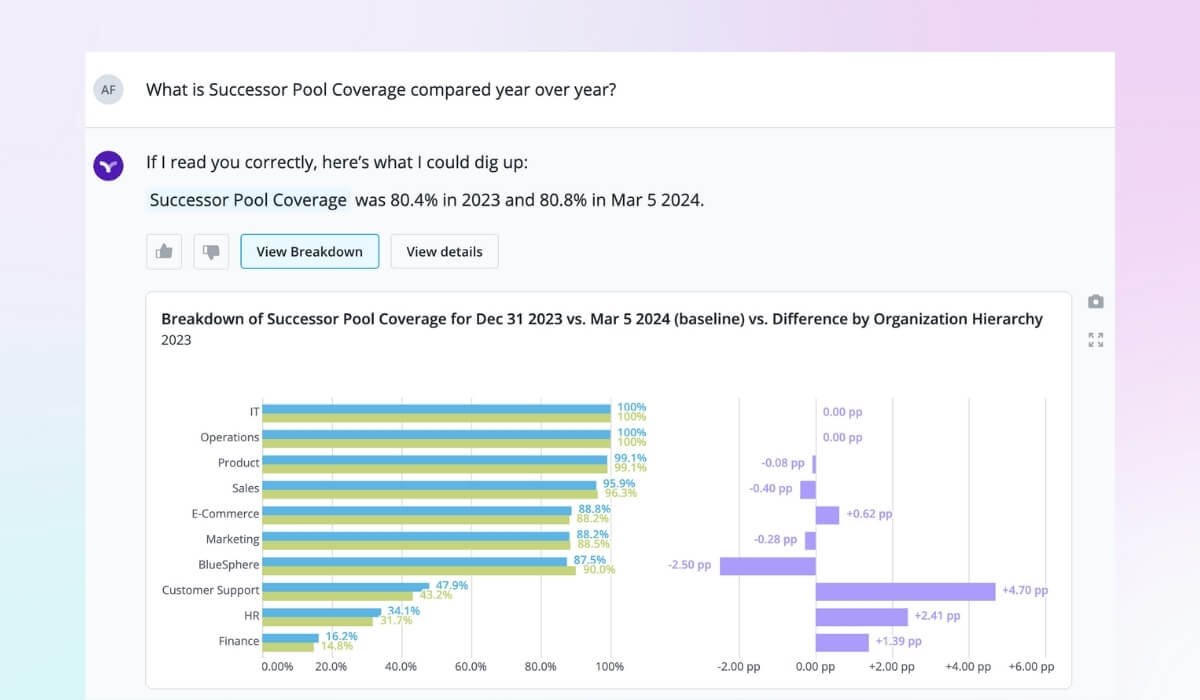
Managerial attrition can create great challenges for organizations if not well managed. One critical strategy for minimizing potential negative impacts is maintaining a strong successor pool that can be turned to when management positions become available. Monitoring the ebbs and flows in the successor pool can help organizations identify where they need to be more proactive in identifying successors—or where they may need to make shifts and adjustments.
Declining successor pool coverage can signal the need for more leadership training and development and proactive efforts to identify and groom high-potential employees. Comparisons in pool coverage can also yield important insights. Here, for instance, it’s clear that Finance, HR, and Customer Support may require more attention and effort to build successor pools.
12. What's the breakdown of successors by readiness level and position?

The readiness level of successors helps organizations see where, and in what roles, they have successors ready to move at specific points in time. For instance, you can slice and dice this information into time periods like now, within a year, or two to three years. It’s a bench strength metric that helps learning and development (L&D) teams prioritize and deploy leadership development efforts.
Vee can display this information at a glance, allowing users to quickly see areas of strong readiness and areas where additional effort is needed to ensure smooth succession.
13. What are absence days costing the organization?
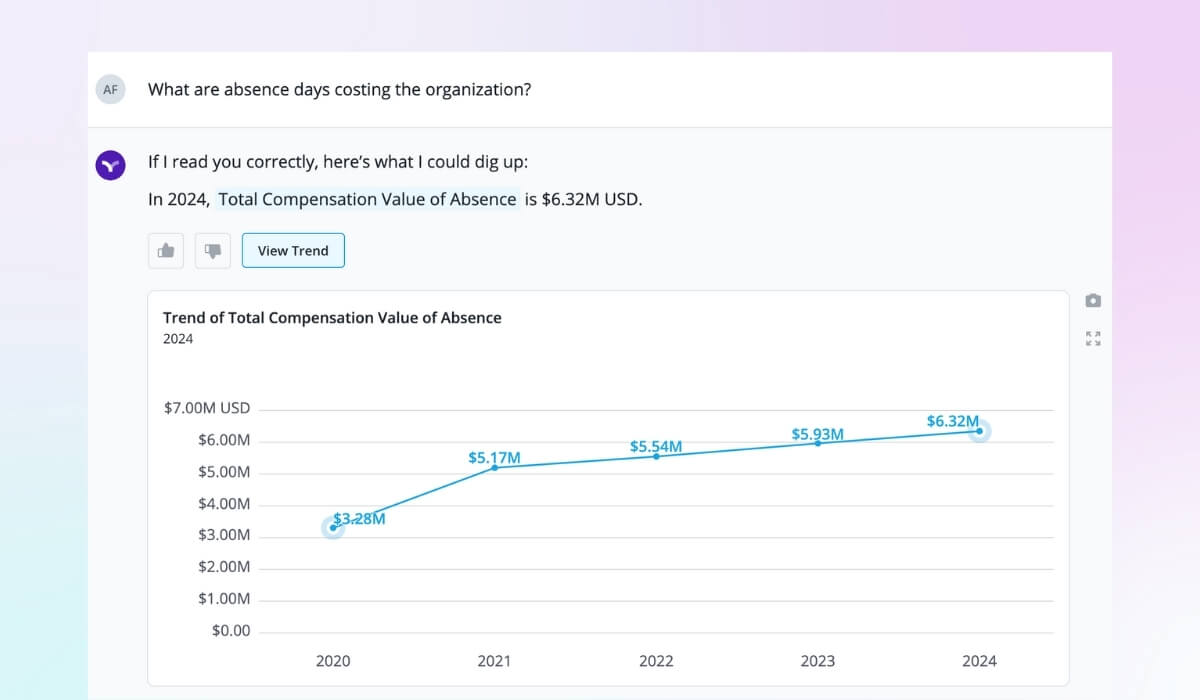
Employee absenteeism comes with a cost, but how high is that cost? Vee can tell you the cost of absenteeism so you understand the precise business impacts of absenteeism and how it's changed year over year.
This data can be applied to specific areas of the company where absenteeism may be a concern, providing a dollar value that can be used to justify intervention efforts like coaching, training, or salary adjustments.
14. Which high performers have the greatest risk of leaving in the next year?
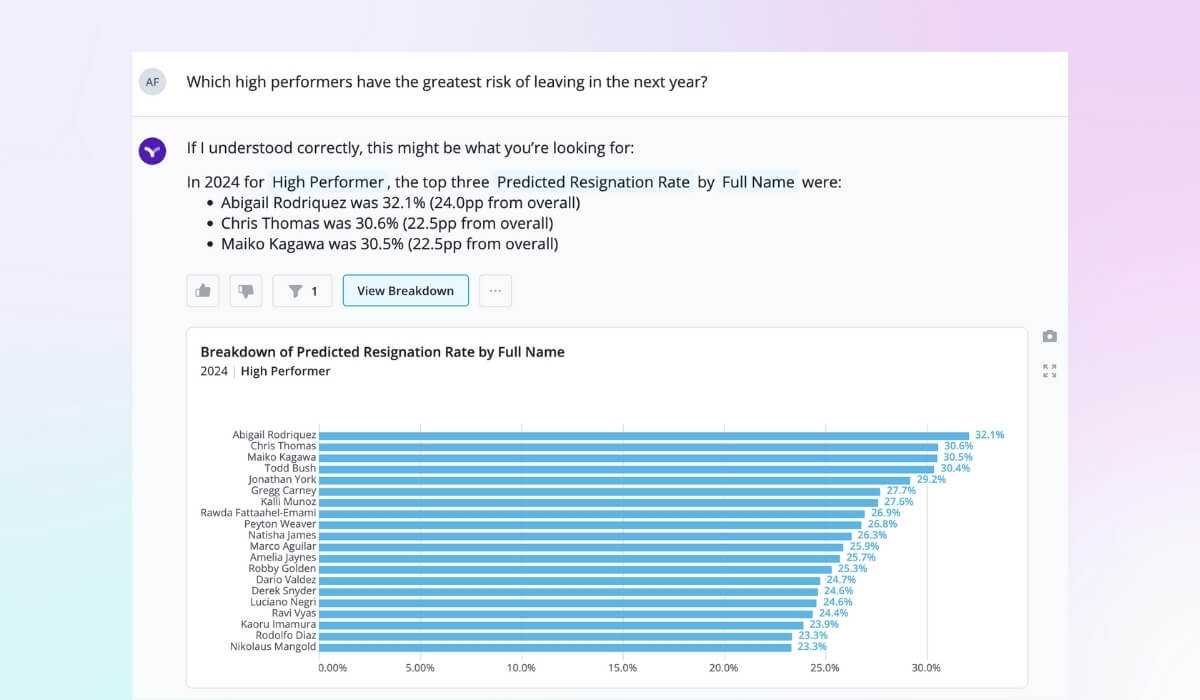
Vee gives HR teams the ability to quickly see where they are most at risk of losing top talent down to the individual employee level. These risks may be related to low compensation ratios, lack of development opportunities, poor management, or leadership mandates like a hardline approach to return-to-office (RTO) policies.
With insights into high performers who may be at risk for turnover, organizations can take actions to improve engagement and retain these valuable workers, boosting engagement and productivity, and maintaining institutional knowledge.
15. How is employee tenure changing?

According to EBRI, for the past 40 years the median length of service for all workers 25 or older has remained relatively steady at about five years. That can be a good benchmark, for comparison, but it’s a pretty broad and general metric. Viewing your organization's data trends over time can provide more meaningful, more precise insights.
Just as environmental impacts on companies change over time, so do impacts on employees. Companies that once realized low levels of turnover may find that these levels climb for any number of reasons. Not staying on top of emerging trends can be costly.
Even positive shifts in retention, as we see here, can be enlightening, providing an indication that employees are satisfied and engaged in their work and with the organization.
Vee gives you instant access to the insights you need for workforce planning
GenAI has the power to transform and enhance your workforce planning efforts. Having access to accurate data and the answers to key questions available at your fingertips helps you gain deeper, more data-driven insights when you need them most so you can influence a critical aspect of your planning efforts.
With no learning curve, and access to your data to fuel precise insights and trends, Vee ensures that your decisions are based on real-time, critical metrics that can make a difference in your planning and forecasting.

Generative AI for HR
Vee, Visier’s generative AI digital assistant delivers fast, intuitive, accessible workforce insights to people leaders. Learn the latest product updates here.
To keep up with the future of work, HR leaders need a strategy that's agile, adaptable, and rooted in data. GenAI can help close the gap between people data and business data. Ian Cook and Robert Sullivan share how.
Vee Boards are AI-augmented dashboards tailored to specific issues of top concern to the C-suite executives. Learn more about them here.
Generative AI innovations like digital assistants are changing the way we work, and pose significant security challenges. Are they secure enough to use with people data?
Vee answers questions about total rewards and compensation. Here are 10 real examples.
